Insert text objects
-
insert objects
-
text art
-
text block formatting
-
font formatting
-
Mail. Getting Started
-
Set font type, size, and color
-
Set font type, size, style, and colors
-
Set font type, size, and color
-
Apply font decoration styles
-
Add hyperlinks
-
Set font type, size, and color
-
Add hyperlinks
-
Set font type, size, and color
-
Apply font decoration styles
-
Add hyperlinks
-
Set font type, size, and color
-
Apply font decoration styles
-
Add hyperlinks
-
Set font type, size, and color
-
Add hyperlinks
-
Set font type, size, and color
-
Apply font decoration styles
-
Add hyperlinks
-
Set font type, size, and color
-
Apply font decoration styles
-
Add hyperlinks
-
Set font type, size, and color
-
Add hyperlinks
-
Set font type, size, and color
-
Apply font decoration styles
-
Set font type, size, and color
-
Apply font decoration styles
-
Add hyperlinks
-
Set font type, size, and color
-
Add hyperlinks
-
Set font type, size, and color
-
Apply font decoration styles
-
Add hyperlinks
-
align text
-
font style
-
Set font type, size, and color
-
Apply font decoration styles
-
Set font type, size, and color
-
Apply font decoration styles
-
Set font type, size, and color
-
Set font type, size, and color
-
Apply font decoration styles
-
Set font type, size, and color
-
Apply font decoration styles
-
Set font type, size, and color
-
Set font type, size, and color
-
Apply font decoration styles
-
Set font type, size, and color
-
Apply font decoration styles
-
Set font type, size, and color
-
Set font type, size, and color
-
Apply font decoration styles
-
text indentation
-
line spacing
In the Spreadsheet Editor, you can draw attention to a specific part of the spreadsheet, for this, insert a text box (a rectangular frame that allows you to enter the text within it) or a Text Art object (a text box with a predefined font style and color that allows you to apply some text effects).
Add a text object
You can add a text object anywhere in the worksheet. To do that:
- switch to the Insert tab of the top toolbar,
- select the necessary text object type:
- click outside of the text object to apply the changes and return to the worksheet.
The text within the text object is a part of the latter (when you move or rotate the text object, the text moves or rotates with it).
As an inserted text object represents a rectangular frame with text in it (Text Art objects have invisible text box borders by default) and this frame is a common autoshape, you can change both the shape and text properties.
You can save the text object as a picture on your hard drive using the Save as picture option in the right-click menu.
To delete the added text object, click on the text box border and press the Delete key on the keyboard. The text within the text box will also be deleted.
Format a text box
Select the text box by clicking on its border to change its properties. When the text box is selected, its borders are displayed as solid (not dashed) lines.

- to manually resize, move, rotate the text box, use the special handles on the edges of the shape.
- to edit the text box fill, line, replace the rectangular box with a different shape, or access the shape advanced settings, click the Shape settings icon on the right sidebar and use the corresponding options.
- to arrange text boxes as related to other objects, align several text boxes as related to each other, rotate or flip a text box, right-click on the text box border, and use the contextual menu options. To learn more on how to arrange and align objects, please refer to this page.
- to create columns of text within the text box, right-click on the text box border, click the Shape Advanced Settings option, and switch to the Columns tab in the Shape - Advanced Settings window.
Format the text within the text box
Click the text within the text box to change its properties. When the text is selected, the text box borders are displayed as dashed lines.
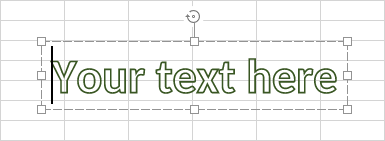
It's also possible to change text formatting when the text box (not the text itself) is selected. In such a case, any changes will be applied to all the text within the text box. Some font formatting options (font type, size, color, and decoration styles) can be applied to a previously selected portion of the text separately.
- Adjust the font formatting settings (change the font type, size, color and apply decoration styles) using the corresponding icons situated on the Home tab of the top toolbar. Some additional font settings can be also changed on the Font tab of the paragraph properties window. To access it, right-click the text in the text box and select the Paragraph Advanced Settings option.
- Align the text horizontally within the text box by using the corresponding icons situated on the Home tab of the top toolbar or in the Paragraph - Advanced Settings window.
- Align the text vertically within the text box by using the corresponding icons situated on the Home tab of the top toolbar. You can also right-click the text, select the Vertical Alignment option and then choose one of the available options: Align Top, Align Center, or Align Bottom.
- Rotate the text within the text box. To do that, right-click the text, select the Text Direction option and then choose one of the available options: Horizontal (is selected by default), Rotate Text Down (sets a vertical direction, from top to bottom), or Rotate Text Up (sets a vertical direction, from bottom to top).
-
Create a bulleted or numbered list. To do that, right-click the text, select the Bullets and Numbering option from the contextual menu, and then choose one of the available bullet characters or numbering styles.
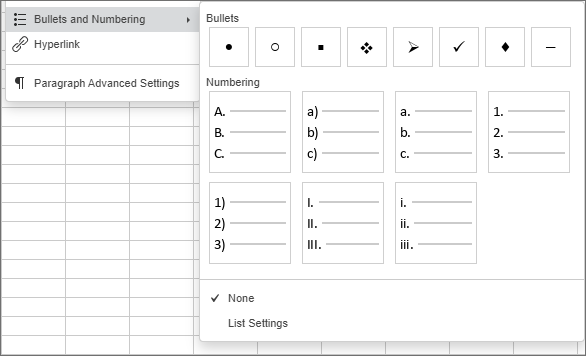
The List Settings option allows you to open the List Settings window where you can adjust the settings for a corresponding list type:
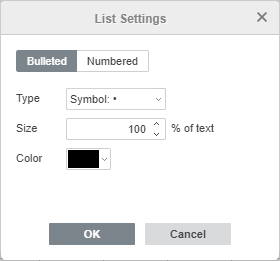
Type (bulleted) - allows you to select the necessary character for the bulleted list. When you click the New bullet option, the Symbol window will open, and you will be able to choose one of the available characters. To learn more about how to work with symbols, please refer to this article.
When you click the New image option, a new Import field appears where you can choose new images for bullets From File, From URL, or From Storage.
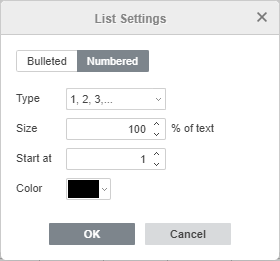
Type (numbered) - allows you to select the necessary format for the numbered list.
- Size - allows you to select the necessary bullet/number size depending on the current size of the text. The value can vary from 25% up to 400%.
- Color - allows you to select the necessary bullet/number color. You can select one of the theme colors, or standard colors on the palette, or specify a custom color.
- Start at - allows you to set the necessary numeric value you want to start numbering with.
- Insert a hyperlink.
-
Set line and paragraph spacing for the multi-line text within the text box by using the Paragraph settings tab of the right sidebar that will open if you click the Paragraph settings icon. Set the line height for the text lines within the paragraph as well as the margins between the current and the previous or the following paragraph.
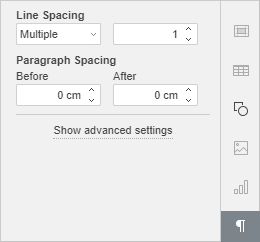
Adjust paragraph advanced settings
Change the advanced settings of the paragraph (you can adjust paragraph indents and tab stops for the multi-line text within the text box and apply some font formatting settings). Put the cursor within the required paragraph - the Paragraph settings tab will be activated on the right sidebar. Click the Show advanced settings link. It's also possible to right-click the text in a text box and use the Paragraph Advanced Settings item from the contextual menu. The paragraph properties window will be opened:

The Indents & Spacing tab allows you to:
- change the alignment type for the paragraph text,
-
change the paragraph indents as related to the internal margins of the text box,
- Left - set the paragraph offset from the left internal margin of the text box specifying the necessary numeric value,
- Right - set the paragraph offset from the right internal margin of the text box specifying the necessary numeric value,
- Special - set an indent for the first line of the paragraph: select the corresponding menu item ((none), First line, Hanging) and change the default numeric value specified for First Line or Hanging,
- change the paragraph line spacing.
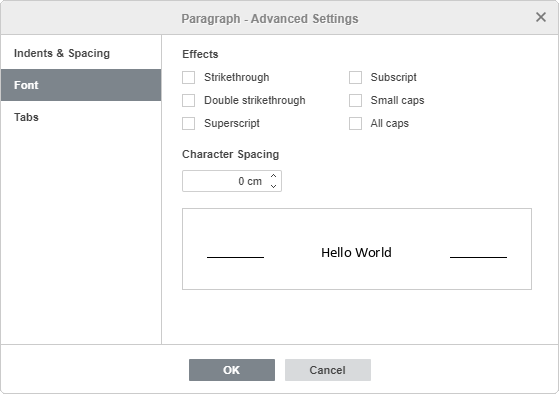
The Font tab contains the following parameters:

The Tab tab allows you to change tab stops i.e. the position the cursor advances to when you press the Tab key on the keyboard.
Assign a Macro to a Text Box
You can provide quick and easy access to a macro within a spreadsheet by assigning a macro to any text box. Once you assign a macro, the text box appears as a button control and you can run the macro whenever you click it.
To assign a macro:
-
Right-click the text box to assign a macro to and choose the Assign Macro option from the drop-down menu.
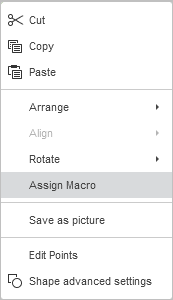
- The Assign Macro dialogue will open
-
Choose a macro from the list, or type in the macro name, and click OK to confirm.
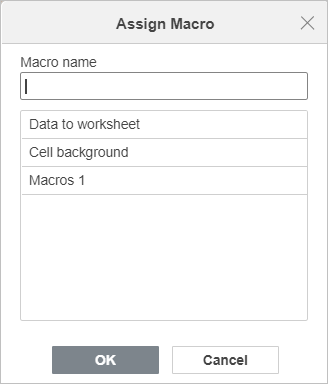
Edit a Text Art style
Select a text object and click the Text Art settings icon on the right sidebar.
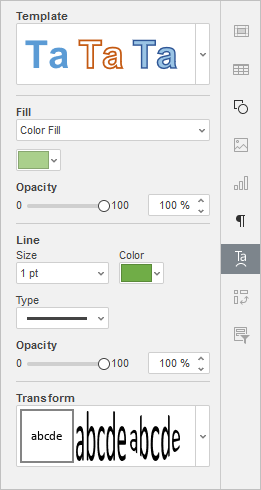
- Change the applied text style by selecting a new Template from the gallery. You can also change the basic style additionally by selecting a different font type, size, etc.
- Change the font fill and line. The available options are the same as the ones for autoshapes.
- Apply a text effect by selecting the necessary text transformation type from the Transform gallery. You can adjust the degree of text distortion by dragging the pink diamond-shaped handle.

Return to previous page